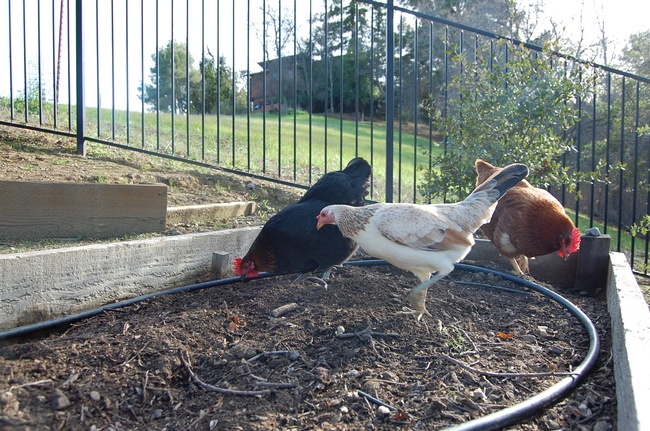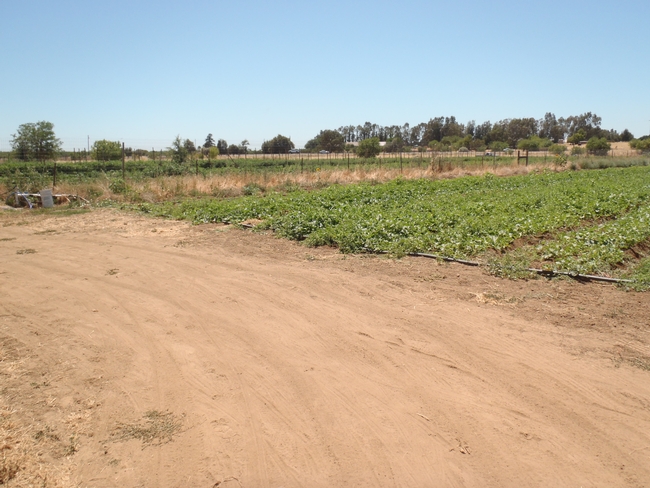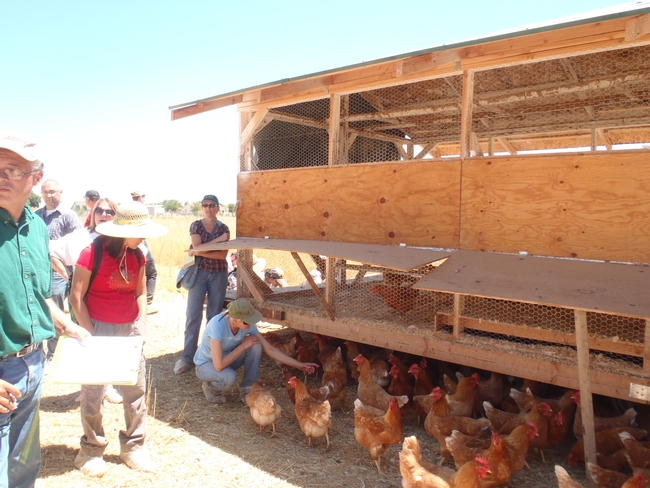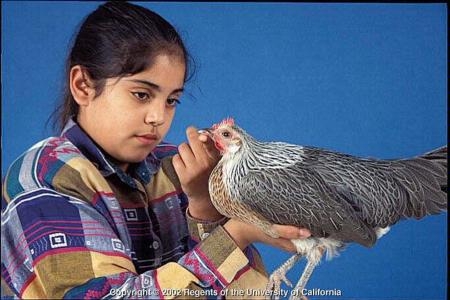Posts Tagged: chickens
A Valentine for the Hens
We are the happy owners of three hens. Three years ago, I picked them out at a local feed store and brought them home. They were two days old, and I was twitterpated.
Eleanor (a black sex-link), Rosie (a New Hampshire red) and nearly feral Amelia (an Egyptian fayoumi) — are a delight. When they’re not molting, they lay delicious eggs, about eight a week. They have controlled the infestations of snails and slugs in our back yard, no small feat. Their digestive tracts keep us stocked with very rich compost, and they tuck themselves into their secure coop each night and are up with the sun each day.
OK, that up-with-the-sun part is annoying. Having hens is not an entirely blissful experience. They are not all-together garden-friendly. When we let them out of their run to forage around the yard, they make a beeline to peck away the leaves of tender seedlings. I must cover our raised vegetable beds with hateful bird netting. And, well, they do their business whenever and wherever they please, requiring a daily poop patrol.
But, dang, their eggs are tasty! And, as evidenced the other day, the girls can be great company. I was in the midst of a garden cleanup, stooped for hours, hand raking wet fallen leaves. The hens stuck by me most of the day, allowing the occasional scratch or clucking in response to my idle chitchat. At least that’s what I thought. I soon realized the girls were watching me gather leaves into piles that I would then pick up and put into our green toter. If I turned my back or didn’t move quickly enough, the hens would charge in and scratch through my leaf piles, seeking fresh bugs to eat. It became a race — me gathering leaves and whisking them away before the eagle-eyed trio could move in and “redistribute” my work.
Hey, it made the work go faster. And many young slugs met their demise that day. Thanks for the help, girls!

Three hens - Eleanor (from left), Amelia and Rosie, hunting and pecking for insects in our fallow raised beds.
Inexpensive Tricks Of The TradeFor Use In Your Own Backyard Homestead
As a budding farmer in Solano County, I frequently attend farm tours to learn new methods for growing edible plants/vegetables and raising livestock. Last week, I had the privilege of attending a lecture presented by Chris Hay of Say Hay Farms. Chris is a thoughtful, conscientious, and entrepreneurial young grower who owns and operates an 8-acre certified organic farm in Woodland, California--just a hop, skip and jump from Solano County. Chris grows diversified vegetables as well as raises pastured chickens for eggs.
I love attending farm tours because each time I have attended one, I learn about a new method of growing, a new trick/technique of the trade, or alternatively, what mistakes not to make in setting up a farm or garden. As relevant to people interested in gardening in particular, one new trick that I learned from visiting Chris’ farm, is the use of table top greenhouses to begin his starts (unfortunately, I have pictures of everything else but these greenhouses, so I’ll do my best to describe them to you). It is a simple device. Chris creates a small tent (think small picnic tent to keep flies off of food), using plastic and PVC piping, and places it over a black plastic seedling tray you would commonly see in seed catalogs. Essentially, it is a tabletop hoop house for his seedlings and looks to be very inexpensive to make. Chris keeps these outdoors during the summer. Chris says that it is effective and has saved him lots of money to start seeds in this manner rather than purchasing seedlings.
As most of you know, backyard chickens are all the rage. Another tip that I learned from visiting Chris’ farm that you can apply to your own backyard chicken coop, is painting a farm white wash on the interior walls of your chicken coop/house to reduce or prevent mites (a chicken parasite that is very difficult to get rid of). There are various recipes for farm white wash which you can google, all of which are usually inexpensive, but in general, it consists of some combination of lime, salt, alum, molasses, sodium chloride and water. Chris said that the white wash flakes off annually, so he has to repaint the inside of his chicken coops every year; however, he has never had any issue with mites as a result of using the white wash (and keeping the coop clean and dry and adding food-grade safe diatomaceous earth) and he raises approximately 500 chickens.
So there you have it—tips from the professionals that you can incorporate on a small scale into your own backyard that are both inexpensive and effective.

Chris' farm. (photos by Betty Homer)

Inside the chicken coop.

Outside the coop.
Urban chickens are fun and a current fad
Cities throughout the United States and Canada are reforming land-use and health policies to allow and encourage urban agriculture - including raising chickens, wrote Josie Garthwaite in the New York Times.
Among her sources for the story was the director of UC Cooperative Extension's Statewide Master Gardener Program Pamela Geisel, who keeps 10 hens at her own rural home west of Chico.
She said enthusiasm for homegrown hens in urban areas may be close to peaking.
“It’s sort of a fad,” she said. Still, “it’s easy to buy chicks, and they’re cheap."
Most of the potential problems tend to arise from having too many chickens in too little space, she said, so regulations for the size and housing of backyard flocks can “help chicken keepers be better chicken keepers.”
She cautioned that keeping chickens involves a significant effort.
“The poop just doesn’t go away — it’s a constant daily cleanup,” she said. “They get sick, they get parasites. For many people it’s just not worth the effort.”
California's growing marijuana business impacting agriculture
Harry Cline, Western Farm Press
California has the dubious distinction of being America’s biggest marijuana supplier. Approximately 75 percent of the marijuana sold in the U.S. is grown in California — not Mexico.
Michelle Le Strange, UCCE farm advisor in Tulare County, said she has been warned by county officials and law enforcement officers that she should be alert in driving a county vehicle in rural areas because marijuana plantation tenders might think she is a law enforcement officer, and she could be in danger.
Any government officials driving vehicles with government plates should be concerned because these marijuana plantations are operated by Mexican drug cartels, the same lawless gangs who are responsible for thousands of murders each year in Mexico. These cartels actually scour the U.S. Forest Service lands in search of ideal growing sites, often adjacent to running streams. The cartels stock these plantations with people, drip irrigation tubing and chemicals to farm the illegal weed.
Any chicken can shed salmonella
Last month's enormous egg recall continues to generate news coverage about efforts to keep salmonella-contaminated eggs out of the U.S. food supply.
Experts quoted in a Los Angeles Times story published yesterday agreed that salmonella contamination can happen in any egg production system - large operations, small family farms or in the backyard. Chickens infected with salmonella shed the pathogen in their feces, which can contaminate the egg shell. In rare instances, salmonella infects a hen's ovaries and can end up inside the eggs she lays, the article said.
A Texas A&M University professor said eggs from large-scale producers should, theoretically, be safer because they are subject to state and federal regulations requiring inspections and regular testing for pathogens, including salmonella.
A Louisiana State University professor said the cages on commercial farms have slanted bottoms so eggs roll out right after they're laid, making it less likely they will come in contact with hen droppings.
Michele Jay-Russell, food safety specialist at the Western Institute for Food Safety and Security at UC Davis, told reporter Elena Conis when a foodborne illness breaks out in a large commercial concern, the problem becomes a huge, national problem very quickly. But that doesn't mean smaller-scale production is safer.
The article cited two studies comparing the occurrence of salmonella in free-range and conventionally produced eggs:
- A 1996 study published in the journal Avian Disease found higher levels of a specific type of salmonella in free-range compared to caged birds.
- A 2004 study conducted by researchers at the Poultry Microbiological Safety Research Unit at the Richard B. Russell Agricultural Research Center in Athens, Ga., found no difference in salmonella levels in free-range chickens compared to conventionally raised chickens.

Backyard producers should also take precautions to avoid foodborne illness.
Egg recall collides with California's Prop 2
As producers and government agencies continue to investigate last month's enormous recall of Iowa-produced eggs, California egg farmers are pondering whether new rules that will govern the state's hen houses will play a role in preventing or exacerbating egg-borne illness, said an article in the San Francisco Chronicle.
Proposition 2, enacted by a wide margin of California voters in 2008, will require egg producers to provide adequate room for their hens to turn around freely, lie down, stand up and fully extend their limbs.
A Humane Society of the United States spokesperson told Chron reporter Carolyn Lockhead that the evidence is "very clear" that caging laying hens increases the risk of salmonella. However, Ralph Ernst, extension poultry specialist emeritus at UC Davis, who helped write California's voluntary egg production rules, told her that cages "are more sanitary than any other housing system, period."
A farmer quoted in the story said the caged environment separates the birds from their feces.
"In a cage-free environment you do not do that," Petaluma farmer Arnie Riebli said. "You allow the birds to walk in it and you allow the birds to eat it. Believe me, all you're doing is feeding them bacteria. Would you allow a small child to play in his excrement or eat his excrement?"
How regulators will interpret and enforce Prop 2's requirements are still unclear. Some farmers believe larger, "furnished" cages will be allowed.
Dan Sumner, director of the UC Agricultural Issues Center, said there is no reason to think that cages have any specific effect on the food safety aspect of the eggs.
"Cage-free is probably more dangerous when it comes to salmonella," Sumner was quoted.


